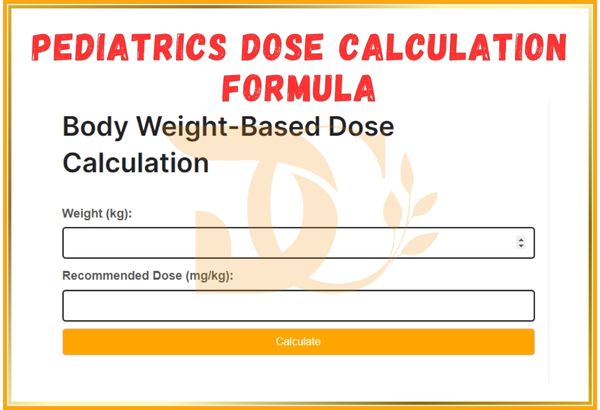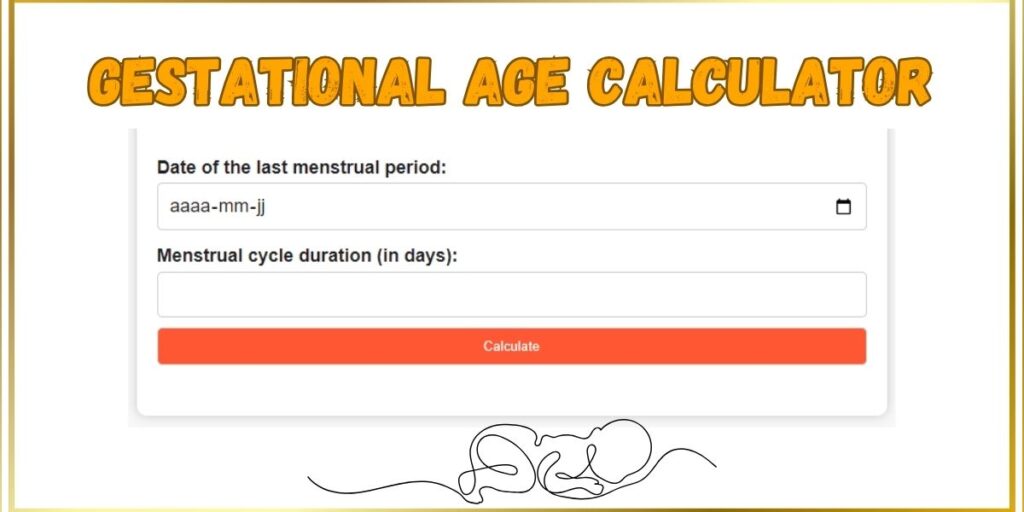This Gestational Age Calculator helps you to calculate your gestational age from your (last menstrual period) and estimate your due date (“date of delivery”).
Gestational Age Calculator
Only digits 0 to 9 and a single decimal point (“.”) are acceptable as numeric inputs. Attempted input of other characters into a numeric field may lead to an incorrect result.



What is gestational age?
Gestational age is a measure that determines your current stage in pregnancy. Your healthcare provider relies on gestational age in weeks, as opposed to months, to strategize and manage your prenatal care. Typically, pregnancies span approximately 40 weeks from the onset of your last menstrual period.
Gestational Age Calculator Formula :
Gestational Age (GA) = Current Date - Date of LMP
Late of LMP = Estimated due date (EDD) - 280 days
where:
EDD: the estimated due date.LMP: s the last menstrual period.GA: the gestational age.
Alternative Approaches for Estimating Gestational Age
Clinical Assessment
A pelvic examination, when combined with accurate menstrual records in the first trimester, has been noted as a dependable method for dating pregnancy [9].
Doppler Ultrasonography
In most cases, Doppler ultrasound can detect the fetal heartbeat between 10 to 12 weeks into the pregnancy, indicating a minimum gestational age of 10 to 12 weeks when fetal heart tones are audible.
Human Chorionic Gonadotropin (hCG) Pregnancy Test
Human chorionic gonadotropin (hCG) becomes detectable in a mother’s blood and urine approximately 6 to 14 days after fertilization, which corresponds to 3 to 4 weeks of gestational age. Therefore, a reliable hCG pregnancy test suggests a gestational age of at least 3 to 4 weeks.
Embryological Age
Embryological age is defined as the period between conception and delivery, which is two weeks less than gestational age. Women can estimate the date of conception using at-home hormonal tests or by measuring their basal body temperature to identify their ovulation period. However, the date of conception is certain only in the case of in vitro fertilization or other assisted reproductive methods.
Physical Parameters After Birth
After birth, the doctor can also use methods such as the Ballard score to assess gestational age based on the physical characteristics of the newborn, such as weight, size, organ maturity, and cartilage flexibility.
Why Is Gestational Age Calculation Important?
Estimating Due Dates:
Determining the gestational age is crucial for estimating the due date or expected delivery date. Knowing when a baby is likely to arrive helps parents prepare and healthcare providers plan prenatal care.
Monitoring Fetal Development:
Gestational age is used to assess the growth and development of the fetus. It helps identify potential issues or delays in development that may require medical attention.
Assessing Health Risks:
Premature birth (birth before 37 weeks of gestation) and post-term birth (birth after 42 weeks of gestation) are associated with increased health risks for both the baby and the mother. Accurate gestational age determination helps healthcare providers identify and manage these risks.
Timing Interventions:
In some cases, medical interventions, such as inducing labor or scheduling a cesarean section, may be necessary. Gestational age plays a vital role in determining when these interventions are appropriate.
FAQ
What is the optimal gestational age for childbirth?
Pregnancy is deemed full-term at 37 weeks. Nevertheless, the fetus’s lung development is typically complete by 34 weeks, affording a strong likelihood of survival outside the womb from that juncture.
In summary, a baby born after 34 weeks of pregnancy may experience similar health outcomes as their peers born at full-term!
How is gestational age typically quantified?
Gestational age is commonly assessed in weeks, with a complete pregnancy spanning approximately 40 weeks or 280 days.
How is gestational age determined?
Gestational age can be calculated through the following methods:
- Utilizing the date of the last menstrual period.
- Evaluating it through ultrasound measurements of the fetus.
- Employing the fertilization date if it is known.
How to Calculate Pregnancy Age
The estimated date of delivery is the expected date for childbirth and can be calculated in different ways:
- By adding 266 days to the date of conception.
- By adding 280 days (equivalent to 40 weeks) from the first day of the last menstrual period. This is applicable to women with regular menstrual cycles of 28 days.
- By adding 280 days plus the difference between the actual length of the menstrual cycle and 28 days for women with irregular menstrual cycles.
Important Considerations
Menstrual Cycle:
Women with regular 28-day menstrual cycles can use the standard calculation by adding 280 days (40 weeks) from the first day of their last menstruation. However, for women with irregular cycles, this method may be less accurate.
Last Menstruation:
Obtaining an accurate last menstruation date is essential for a more precise calculation of pregnancy age.
Ultrasounds:
Ultrasounds are often used to confirm gestational age and monitor fetal development throughout pregnancy.
Consult a Healthcare Professional
For an accurate calculation of pregnancy age and proper medical monitoring, it is crucial to consult a healthcare professional, such as an obstetrician or midwife.
Conclusion
Gestational age is a critical factor in the care and management of pregnancy. Whether calculated based on the last menstrual period, ultrasound measurements, or the conception date, it provides valuable information for healthcare providers and expectant parents. By accurately assessing gestational age, healthcare professionals can ensure the best possible outcomes for both mother and baby during pregnancy and childbirth.


Leave a Reply